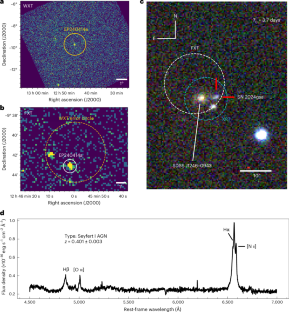2025-07-01 中国科学院(CAS)
<関連情報>
- https://english.cas.cn/newsroom/cas_media/202507/t20250701_1046538.shtml
- https://www.nature.com/articles/s41550-025-02571-1
Ic-BL型超新星に伴う弱い相対論的ジェットからの高速X線過渡現象 A fast X-ray transient from a weak relativistic jet associated with a type Ic-BL supernova
H. Sun,W.-X. Li,L.-D. Liu,H. Gao,X.-F. Wang,W. Yuan,B. Zhang,A. V. Filippenko,D. Xu,T. An,S. Ai,T. G. Brink,Y. Liu,Y.-Q. Liu,C.-Y. Wang,Q.-Y. Wu,X.-F. Wu,Y. Yang,B.-B. Zhang,W.-K. Zheng,T. Ahumada,Z.-G. Dai,J. Delaunay,N. Elias-Rosa,… H. Zou
Nature Astronomy Published:26 June 2025
DOI:https://doi.org/10.1038/s41550-025-02571-1

Abstract
Massive stars end their lives as core-collapse supernovae, among which some extremes are broad-lined type Ic supernovae from Wolf–Rayet stars associated with long-duration gamma-ray bursts (LGRBs) with powerful relativistic jets. Their less-extreme brethren make unsuccessful jets that are choked inside the stars, appearing as X-ray flashes or low-luminosity GRBs. However, there exists a population of extragalactic fast X-ray transients with timescales ranging from seconds to thousands of seconds, whose origins remain obscure. Here we report the discovery of the bright X-ray transient EP240414a detected by the Einstein Probe, which is associated with the type Ic supernova SN 2024gsa at a redshift of 0.401. The X-ray emission evolution is characterized by a very soft energy spectrum peaking at <1.3 keV, which makes it different from known LGRBs, X-ray flashes or low-luminosity GRBs. Follow-up observations at optical and radio bands revealed the existence of a weak relativistic jet that interacts with an extended shell surrounding the progenitor star. Located on the outskirts of a massive galaxy, this event reveals a population of explosions of Wolf–Rayet stars characterized by a less powerful engine that drives a successful but weak jet, possibly owing to a progenitor star with a smaller core angular momentum than in traditional LGRB progenitors.



